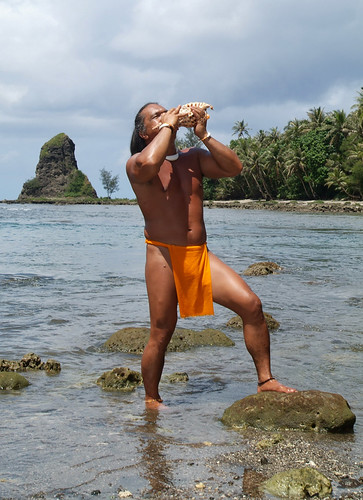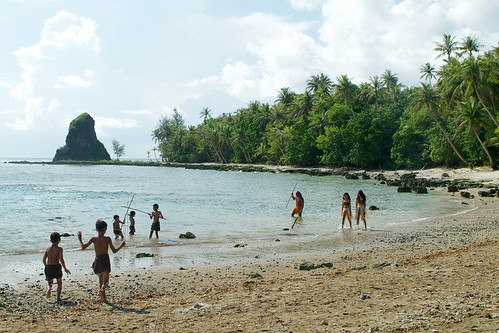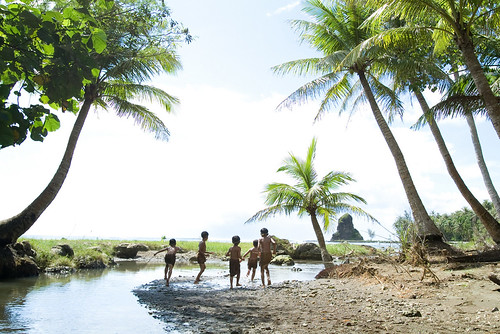Cradle of civilization
Fouha Bay, located just north of Humåtak on Guam’s southern west coast at the mouth of Fua River, holds thousands of years of meaningful history. It is one of many sites CHamorus believe to be spiritually powerful.
The bay and river are also referred to as Fua, Fu’a, Fuha or Fuja. Some have also called it Fu’una (Fona, Fuña, Fuuna, Fu’una or Fuuña). Fouha/Fu’a may be a derivative of Fu’una.
Guam CHamorus traditionally consider Laso Fu’a, or Lasu Fua, the rock pillar that juts out of the ocean reaching toward the sky in Fouha Bay, the cradle of creation for the people of the Mariana Islands, and in some accounts, for all of humankind.
Laso Fu’a, the remains of Fu’una in the creation story of Puntan and Fu’una, is considered one of the most important CHamoru oral traditions. It provides an explanation for how the CHamoru people came to be, while providing moral and societal messages as well, such as the importance of family working together.
CHamorus in the northern Mariana islands have their own creation points, though the creation story is the same. There are well-known outlines of a man and a woman in the Saipan landscape, for example, which is interpreted as Puntan and Fu’una as well. Rota was also documented to have a town of Fuuña.
Archaeological artifacts that line the bay are signs of a vibrant ancient CHamoru presence and usage of the area, including some of the earliest examples of ancient CHamoru pottery. These reminders of the lives and times of ancient CHamorus are especially concentrated north of Fua River which flows into the bay. Given the area’s prime coastal location and rich resources, such as fresh water, marine resources, and coconuts and pandanus, it is easy to envision the lives and activities of the ancient CHamoru that were once there. Modern CHamorus speak of feeling the presence of ancient CHamorus and the area’s spiritual significance while at Fouha Bay.
Ancient CHamorus set aside a time each year to gather and pay homage to their creators and creation point, as documented in early Spanish accounts.
There is some disagreement as to whether one or two such respected places existed. Some now interpret known information to mean that there were two separate places—one ‘female’ and one ‘male’–that were respected and paid tribute to in ancient CHamoru times. There are also others who interpret Laso Fu’a as actually Fu’una near Hågat. Though the location of Fu’a has been contested by a few recent academics, CHamorus follow the oral traditions nested within their cultural system.
Early European maps and documents from the 1600s and 1700s, note that a rock/isle/islet and a town (village) of Fuuña existed near Hågat. Some of these early accounts state that Fu’una was “looked upon…with a sacred dread, as the birth-place of the human race.”
This so-called “pagan” activity was stomped out by the Spanish missionaries in the 1600s. The missionaries destroyed places considered spiritually significant to ancient CHamorus and at times constructed their own missions on those sites to demonstrate the power of Christianity and the Catholic Church, as they documented doing to the respected place of Fu’una.
These types of efforts of the Spanish had some success but never fully erased the CHamoru belief in and respect of their spiritually powerful places or their belief in the presence and power of their taotaomo’na or ancestral spirits who protect and watch over the people and the land.
There are many examples where CHamorus intermingled the introduced Catholic faith with their ancestral beliefs and practices. Some CHamorus tell of ancient traditions that have continued into modern times, such as the 1954s account by Bill Lujan that noted when ‘people make the pilgrimage to Humåtak on San Dionicio Day, in honor of the patron saint of the village, they usually include (a stop at) Laso Fu’a in their itinerary.
Not only does Fouha Bay have ancestral significance to the CHamoru people, but it is also part of the area according to oral tradition where ancient CHamorus first had contact with the Spanish colonizers, an encounter that is re-enacted and commemorated each March in Humåtak on Discovery Day. The southern village was a relatively busy and important port for receiving foreign vessels from the time of early CHamoru-Spanish contact through much of the Spanish rule over the Mariana Islands.
Fouha Bay was a part of the road system that linked the people and goods that came in through Humåtak to Hagåtña. The early Spanish San Jose Church and the Battery of San Jose are associated with Fouha Bay as well.
CHamorus have begun to venture once again to Fouha Bay to pay homage to Laso Fu’a. In one recent example the sound of conch shells being blown and chants filled the air when the Hawai’ian deep sea voyaging canoe, the Makali‘i passed through the Mariana Islands in 2001. A respected CHamoru chanted, recognizing that “the rock in front of us is the birthplace of all people,” at the welcoming ceremony.
People left offerings such as katupat, a diamond shaped woven coconut packet of cooked rice, while paying homage there and asking for permission to enter Guam. Laso Fu’a is growing as a symbol of a returning to and a respecting, validating, and revitalizing of ancient CHamoru and their belief system and cultural practices.
By Lina Taitingfong and Kelly G. Marsh-Taitano
For further reading
I Ma Gobetna-na Guam: Governing Guam Before and After the Wars. The Hale’-ta Series. Hagåtña: Political Status Education Coordinating Commission, 1994.
Herman, RKD. “Guam: Inarajan – Arrival: The Ancients.” Pacific Worlds.
Lévesque, Rodrigue. History of Micronesia: A Collection of Source Documents. Vols. 4-6. Québec: Lévesque Publications, 1993-1995.
Sanchez, Anthony P. “Guam’s Umatac – Chamorro Cradle of Creation.” Pacific Daily News, 26 April 2005.





